The Cherry G80-3494 MX Board Silent Mechanical Keyboard Review: Updating a PC Classic
by E. Fylladitakis on September 20, 2017 8:00 AM EST- Posted in
- Peripherals
- Keyboard
- Cherry MX
- Mechanical Keyboards
The Cherry G80-3494 MX Board Silent Mechanical Keyboard
A first look at the Cherry G80-3494 MX Board Silent reveals an oversized, tall keyboard with a plastic body, with the only thing visually separating it from common 80s keyboards being its black color. It takes a closer inspection by an advanced user to reveal that this is a high quality mechanical keyboard, or an experienced eye to recognize the legendary Cherry G80 design.
We received the US layout version of the Cherry G80-3494 MX Board Silent. It adheres fully to the 104 keys ANSI layout, without any extra keys or modifications. It has a 6.25× Spacebar and seven 1.25× bottom row keys. Cherry is using a classic font on the keycaps, with the letters identical to their first G80 keyboards from the early 90’s but with sharper punctuation marks. There are no extra keys, no keystroke combinations, not any kind of advanced functions.
The Cherry G80-3494 MX Board Silent is a relatively tall keyboard but not too tall, designed for maximum typing comfort. It is just tall enough to allow for comfortable typing without the user’s wrists touching the desk or the keyboard. For long typing sessions though, a proper wrist rest will most likely be a necessity to professionals.
Beneath the keyboard we find only two small tilt adjustment feet. The feet are made of clear plastic. Despite their size, they are surprisingly good at holding the large keyboard firmly in place.
Removing some of the keycaps reveals the new Cherry MX Silent switches. These switches are the new variant of the original Cherry MX linear switches that have been redesigned to limit their noise output, which can be a major problem in some applications. Last year we saw the first commercial keyboards featuring these switches when we reviewed the Corsair Strafe RGB. Our Cherry G80-3494 MX Board Silent sample features the black variant of the switch, which is a little stiffer.
Opening up the plastic body of the Cherry G80-3494 MX Board Silent is very easy, as there are hardly any screws to be found on the keyboard. Almost everything is held together with plastic locks and clips. A small screwdriver or other similar tool is more than enough to undo the clips and crack open the plastic body of the keyboard. Inside the keyboard we found a classic black PCB with the mechanical switches attached to it.
There is nothing advanced on this PCB; there are only the switches and a few passive components, with most of them being classic film resistors. A basic USB controller chip can be found on the small green PCB at the top right side of the keyboard, where the three indicator LEDs are. There is no onboard memory or advanced microcontrollers to be found here, as they would not serve any purpose and counter this keyboard’s intended design, which is based on maximizing its reliability.
As best as anyone at AnandTech can recall, this is the first mechanical keyboard that we have seen to not have a metal frame/support for the switches. Instead it relies entirely on the PCB for mechanical cohesion. It probably is not as resistant against heavy physical blows, yet it should be more than sufficiently sturdy for typical everyday use. What frustrated us is the extensive dead space inside the keyboard’s plastic body, which, in an example of just how far technology has progressed in the last couple of decades, is enough space to fit an entire modern low-power PC. Cherry obviously wanted to keep the keyboard’s frame unchanged as it has been out for decades but, on the other hand, that is a lot of space being wasted there.


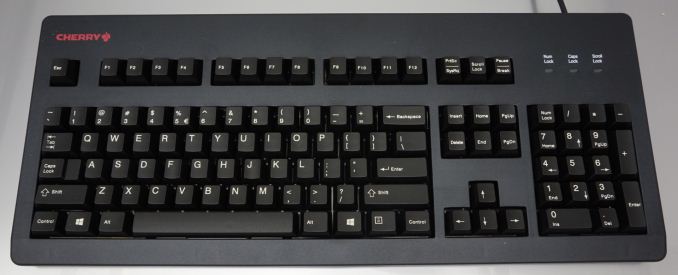
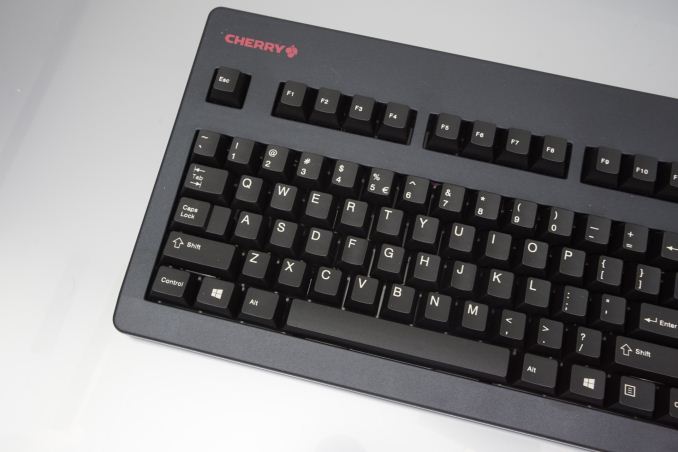
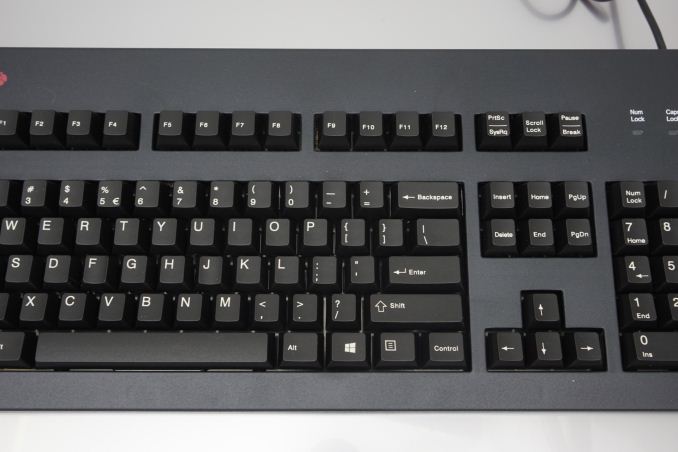
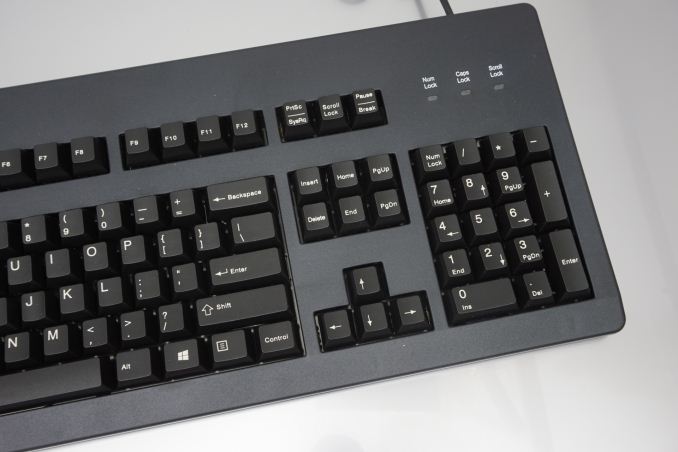
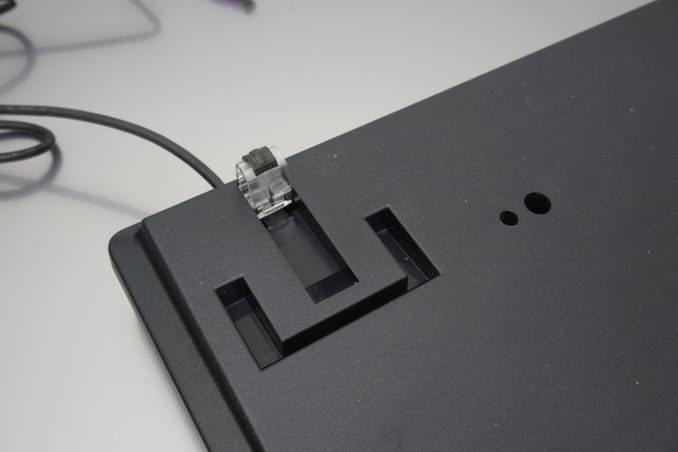

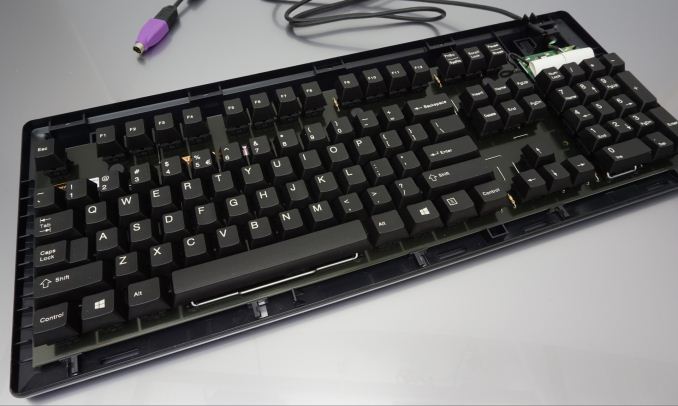








51 Comments
View All Comments
imaheadcase - Wednesday, September 20, 2017 - link
I don't understand why keyboards don't put dedicated media controls on them anymore. The problem with keyboards now is that they try to condense them down. Being able to mute/turn volume up and down, skip tracks, etc is fantastic when doing other things in full screen apps.The way they put them on keyboards now is very cheap way about it, not only that but because of it you have to disable some keys to make them work, and windows won't recognize the media keys to even use them! For example i like my CMstorm keyboard, but its media keys won't work with web based apps like google play music. Or it won't detect some windows borderless games.
However my old Logitech keyboard has no problem doing it. I mean come on, it can't cost much to put real media keys on keyboard, literally plenty of space to do so most mechanical keyboards have a huge height to them. You can put them on top/back and be easier to muscle memory remember location on top/back of them.
Biggest pet peeve of mine with keyboards. :P
imaheadcase - Wednesday, September 20, 2017 - link
To clarify what i mean, if you are playing a game on my CMstorm for example, the F5-F11 keys are the media keys, but to use them you have to disable function button, then press them to use them. Being a gaming keyboard, people use those keys for other things in games. So its cumbersome to have to reach for two keytrokes back and forth to keep enabling/disabling them for each time you want to skip track, pause, etc.Given how many people play games with music you get how its annoying.
blackworx - Wednesday, September 20, 2017 - link
Personally I'm glad the trend for media keys and replacing F keys' default function with media controls is on the wane. I'm pretty sure I'm not the only one. Gaming and media are both still vastly well catered for anyway. There's more choice than ever before, it's just that the rest of us are now less often forced to deal with keyboards that are half broken by default.jimbo2779 - Thursday, September 21, 2017 - link
I wouldn't really say that having dedicated media controls is a gamer keyboard thing, it is a convenience thing. Having the keys for things like media controls or calculator is just convenient.If you don't like these keys you don't need to use them but if they aren't there then the keyboard is missing something.
imaheadcase - Thursday, September 21, 2017 - link
Exactly, its silly spending as much for a one of these keyboards that is actually a regression in tech vs only membrane keyboards.Findecanor - Thursday, September 21, 2017 - link
Manufacturers have not settled on one consistent mapping on F-keys. They each have their own or sometimes a different mapping per keyboard model even.Personally, I use programs that put Skip<, Skip> and Play/Pause on PrtSrc, Scroll Lock and Pause. Those keys are on all keyboards and pretty much useless anyway.
ayabe - Wednesday, September 20, 2017 - link
Good for what it is I guess, I think once you've laid your hands on a Topre switch keyboard, anything Cherry just feels terrible and chintzy by comparison.achinhorn - Thursday, October 5, 2017 - link
First time on a Cherry I dropped almost $200 for a das keyboard only to realize it was basically unusable. I mean really. It maybe that DAS keyboards are garbage but everything felt loose, and the sound, feel, and smoothness of the switches & my Topre were instantly missed. I often lug my Topre to and from the office and bench the Das it's that bad. I don't think I'll ever buy another switch.ithehappy - Wednesday, September 20, 2017 - link
I'm all in for simple keyboards always, but without any backlight it's impossible for someone like me to consider :(grant3 - Wednesday, September 20, 2017 - link
[X] Many pages of non-silence related critique[X] Detailed discussion of interior design of 'silent' keyboard
[ ] Noise output measured on 'silent' keyboard
... -.- ...